
Pseudohydnum gelatinosum is a species of fungus in the order Auriculariales. It has the recommended English name of jelly tooth, a reference to its gelatinous consistency and hydnoid (toothed) undersurface. The species was thought to be cosmopolitan, but recent DNA evidence suggests that it is confined to Europe and northern Asia, with superficially-similar taxa elsewhere. A subspecies, Pseudohydnum gelatinosum ssp. pusillum, is found in North America. P. gelatinosum grows on dead conifer wood.

Saccharomycotina is a subdivision (subphylum) of the division (phylum) Ascomycota in the kingdom Fungi. It comprises most of the ascomycete yeasts. The members of Saccharomycotina reproduce by budding and they do not produce ascocarps.

The Ustilaginomycotina is a subdivision within the division Basidiomycota of the kingdom Fungi. It consists of the classes Ustilaginomycetes and Exobasidiomycetes, and in 2014 the subdivision was reclassified and the two additional classes Malasseziomycetes and Monilielliomycetes added. The name was first published by Doweld in 2001; Bauer and colleagues later published it in 2006 as an isonym. Ustilagomycotina and Agaricomycotina are considered to be sister groups, and they are in turn sister groups to the subdivision Pucciniomycotina.

The Auriculariales are an order of fungi in the class Agaricomycetes. Species within the order were formerly referred to the "heterobasidiomycetes" or "jelly fungi", since many have gelatinous basidiocarps that produce spores on septate basidia. Around 200 species are known worldwide, placed in six or more families, though the status of these families is currently uncertain. All species in the Auriculariales are believed to be saprotrophic, most growing on dead wood. Fruit bodies of several Auricularia species are cultivated for food on a commercial scale, especially in China.
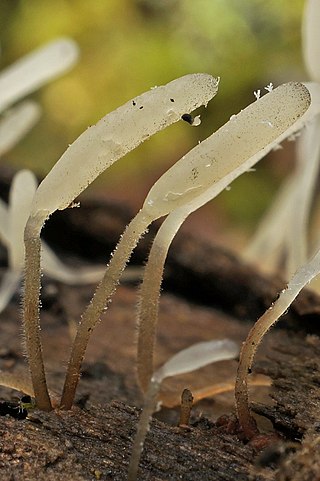
The Typhulaceae are a family of clavarioid fungi in the order Agaricales. Basidiocarps are small, simple, and typically club-shaped with a distinct stem. The family originally contained several genera, including Macrotyphula and Ceratellopsis, but molecular research, based on cladistic analysis of DNA sequences, has shown that only the type genus Typhula belongs in the Typhulaceae, the other genera being synonyms or belonging to other families. The monotypic genus Lutypha has not yet been sequenced.

Rhizocarpaceae is a family of crustose, lecideoid, lichen-forming fungi and together with the family Sporastatiaceae it constitutes the order Rhizocarpales in the Ascomycota, class Lecanoromycetes.

Rhizocarpon is a genus of crustose, saxicolous, lecideoid lichens in the family Rhizocarpaceae. The genus is common in arctic-alpine environments, but also occurs throughout temperate, subtropical, and even tropical regions. They are commonly known as map lichens because of the prothallus forming border-like bands between colonies in some species, like the common map lichen.

Typhula is a genus of clavarioid fungi in the order Agaricales. Species of Typhula are saprotrophic, mostly decomposing leaves, twigs, and herbaceous material. Basidiocarps are club-shaped or narrowly cylindrical and are simple, often arising from sclerotia. A few species are facultative plant pathogens, causing a number of commercially important crop and turfgrass diseases.
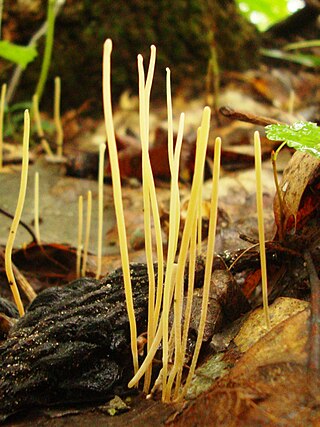
Macrotyphula is a genus of clavarioid fungi in the family Phyllotopsidaceae. Basidiocarps are simple, narrowly club-shaped to filiform, sometimes arising from a sclerotium. They typically grow on dead wood or leaf litter, often in swarms.
Eichleriella is a genus of fungi in the order Auriculariales. Species produce effused or cupulate, waxy to leathery basidiocarps on wood, with a smooth to spiny surface. The genus contains some twelve species.
Heterochaete is a genus of fungi in the order Auriculariales. Species produce effused, gelatinous, waxy, or leathery basidiocarps on wood, partly or wholly covered in small sterile spines or pegs. The presence of these sterile spines distinguishes the genus from Exidiopsis, species of which are microscopically similar but have smooth basidiocarps.

The Ceratobasidiaceae are a family of fungi in the order Cantharellales. All species within the family have basidiocarps that are thin and effused. They have sometimes been included within the corticioid fungi or alternatively within the "heterobasidiomycetes". Species are saprotrophic, but some are also facultative plant pathogens or are associated with orchid mycorrhiza. Genera of economic importance include Ceratobasidium and Rhizoctonia, both of which contain plant pathogenic species causing diseases of commercial crops and turf grass.

Cerinomyces is a genus of fungi in the order Dacrymycetales. Species are saprotrophs and occur on dead wood. As originally conceived, the genus comprised species of the Dacrymycetes having effused, corticioid basidiocarps. Molecular research, based on cladistic analysis of DNA sequences, has however shown that this circumscription is not valid. As a result, the genus now contains some species having corticioid basidiocarps and some additional species with gelatinous, pustular basidiocarps. Around 30 species have been described worldwide.

Dacrymyces is a genus of fungi in the family Dacrymycetaceae. Species are saprotrophs and occur on dead wood. Their distribution is worldwide. Basidiocarps are ceraceous to gelatinous, often yellow to orange, and typically disc-shaped to cushion-shaped.
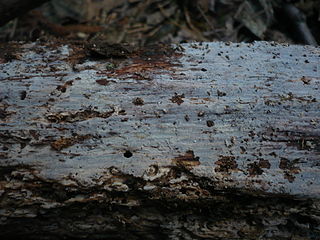
Basidiodendron is a genus of fungi in the order Auriculariales. Basidiocarps are corticioid, thin, effused and are typically found on fallen wood. The genus is widespread in both temperate and tropical regions and contains over 30 species.

Hypochnella is a genus of corticioid (crust-like) fungi. It is one of several genera that were doubtfully placed in the order Atheliaceae based on microscopic morphological simultaneous with core Atheliaceae genera. However, a molecular study with emphasis on Atheliales, including samples across most agaricomycete orders, retrivied the species Hypochnella violacea within the order Polyporales. Although a close relationship between Hypochnella violacea and genus Australohydnum was suggested, resolving the phylogenetic position of Hypochnella within Polyporales was outside the scope of the study. The genus contains two described species.
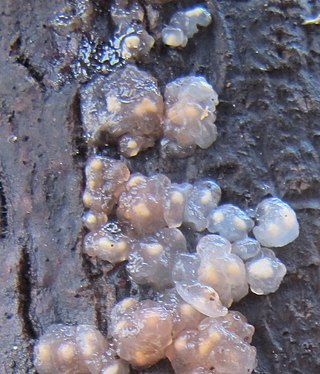
Myxarium is a genus of fungi in the family Hyaloriaceae. Basidiocarps are gelatinous and effused or pustular. The genus is cosmopolitan. All species grow on dead wood or dead herbaceous stems.
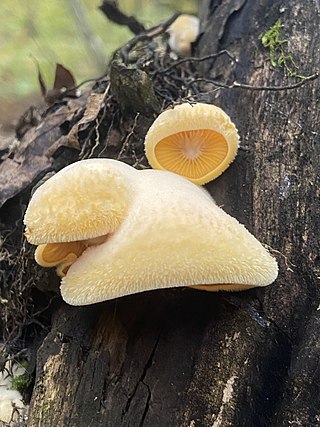
The Phyllotopsidaceae are a family of fungi in the order Agaricales. Basidiocarps are either clavarioid and simple or agaricoid and clustered on wood. The family was established as a result of molecular research, based on cladistic analysis of DNA sequences.

Sarcomyxa is a small genus of agaricoid fungi in the Sarcomyxaceae. Basidiocarps are shelf-like and grow on wood. Sarcomyxa edulis is commercially cultivated for food in Asia.
Heteroscypha is a genus of fungi in the order Auriculariales. Species form cup-shaped, cyphelloid basidiocarps with basidia that are wholly or partly septate. They are presumed to be saprotrophic, growing on dead wood. Originally described in the Tremellales, the genus was placed in its own family, the Heteroscyphaceae, by Jülich and included within the Auriculariales by Wells. Further research is required to determine its true disposition.
















